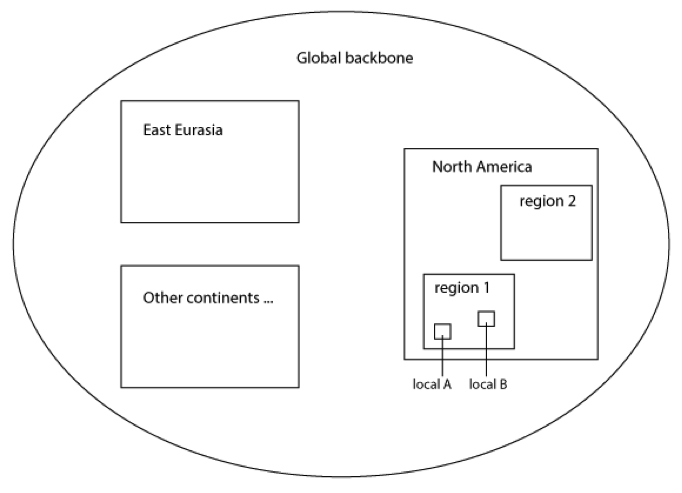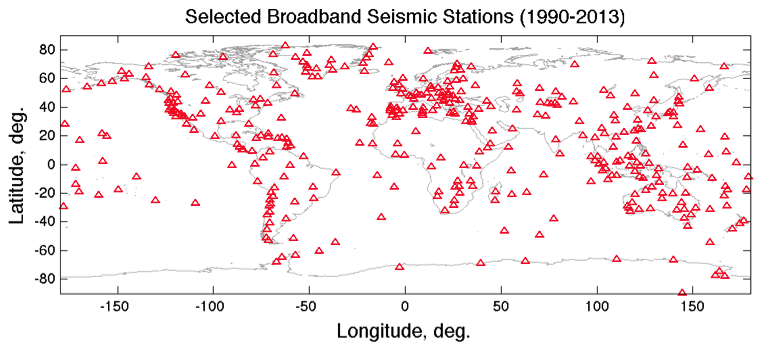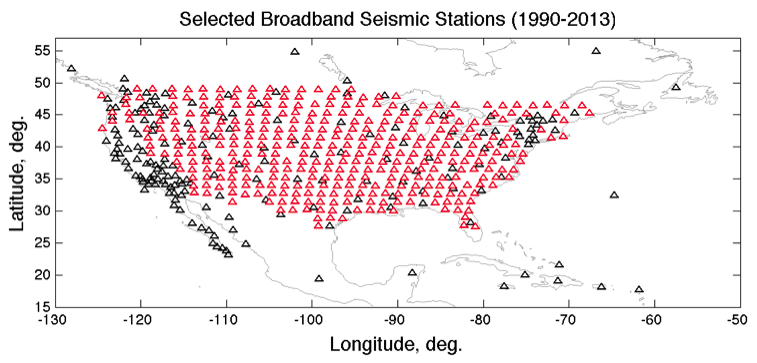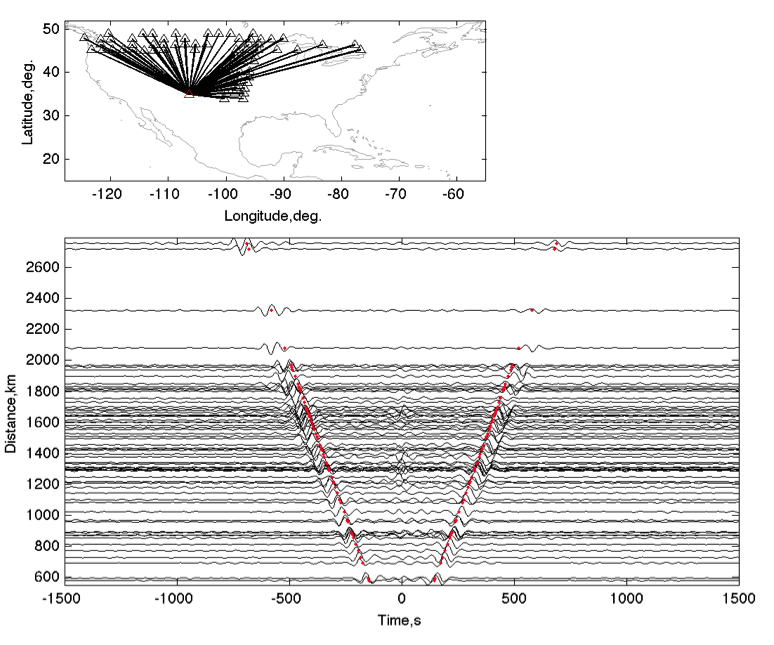Summary
A nested global empirical Green’s tensor (EGT) database derived from three-component continuous data at global, continental and local length scales.
The database is intended to be an open database for anyone to contribute as long as data processing follows a consistent, best practice.
Quicklinks
Currently available:
Note: The ~64,000 EGFs in each of these tar.gz files are the final stacks of all quarterly stacks calculated at U Rhode Island.
Description
Empirical Green’s functions (EGFs) and their three-component form, empirical Green’s tensors (EGTs), can be extracted from ambient seismic records. They have precisely known “virtual source” locations and contain useful surface waves at periods shorter than those from teleseismic earthquakes. For these reasons, they have been widely used to image the crust and uppermost mantle structure (e.g., Shapiro et al., 2005; Yao et al., 2006; Lin et al., 2008). Recent studies demonstrate that ambient seismic records can yield very broadband (up to 600 s period) EGFs, which provide constraints on the crust and entire upper mantle (Nishida et al., 2009; Shen et al., 2012). Various body wave components have also been observed from cross-correlation of ambient seismic records (e.g., Roux, et al., 2005; Ryberg, 2011; Poli et al., 2012). To date, most ambient noise interferometry studies use cross-correlation of vertical-vertical components. This leaves the horizontal components of seismic records unutilized. Yet the cross-correlations of all three components at pairs of stations or EGTs contain rich information about the anisotropy of the Earth structure (e.g., Lin et al., 2008), scattering of waves by heterogeneities, and ground particle polarization, to name a few.
Extracting EGTs from ambient seismic records is data intensive and time consuming. For a global dataset, this means cross-correlation of seismic records from thousands of stations. It is a computationally challenging task, though the benefits of a consistently and systematically processed and high-quality EGT database as an open and shared product for the seismological community may also be enormous. To this end, we (Shen & colleagues, see Contributors below) began the construction of a nested, global EGT database derived from continuous seismic data recorded by selected permanent and temporary stations. The schema of the database involves EGTs at several geographic scales (Figure 1). Selected broadband stations from permanent networks form the “backbone” of the global EGT database (Figure 2). Within this global framework, continental-, regional- and local-scale subsets of data consist of station pairs from the “backbone” stations, other permanent stations, and temporary broadband and short-period stations. Figure 3 shows the stations used in the construction of a continental scale (North America) EGT dataset, with a station spacing of ~150 km. The definitions of regional (100s to 1000s km) and local (10s to 100s km) scales are somewhat arbitrary. Fine scale (meters of kilometers) dense datasets such as those from industrial surveys (Barklage et al., 2014) may also be developed if needed. This multi-level schema reflects the highly uneven distribution of seismic stations and the different frequency characteristics of useful EGTs from the local to global scales. The data processing parameters (Table 1) are chosen to adequately represent EGTs at the various geographic scales at the minimal computational cost. The schema also provides a practical way to process the massive amount of seismic data at the IRIS DMC and other seismic data centers and allows a progressive buildup of the database.
The different target scale lengths are as follows:
- Global: Intermediate- to very long-period (20-600 s) EGTs extracted from seismic data recorded by GSN, GEOFON & other broadband stations with ~1000 km station spacing
- Continental: Short to long-period (8-300 s) EGTs from selected broadband regional networks and temporary deployments (e.g., North America) with 100–1000 km station spacing
- Regional: Short to long-period (4-200 s) waves from broadband regional networks and temporary deployments (e.g. western US) with 10-100 km station spacing
- Local: Short- to intermediate-period (1-30 s) waves from broadband and short-period networks with station spacing of 1-10 km
The database is intended to be non-static: As new seismic data are available from existing stations and new stations are deployed, the database may be updated. It is also intended to be an open database for anyone to contribute as long as data processing follows a consistent, best practice.
Data Processing
Data processing follows the method described in Shen et al. (2012). Continuous seismic data are downloaded from the IRIS DMC and GEOFON. Prior to cross-correlating ambient noise, we remove instrument response, cut the continuous record into 20-day files with a 2-hour overlap, and resample the waveform to a uniform sample rate. The overlap at the ends of each file captures the contribution of the waves at the ends to cross correlation with a time lag of up to 2 hours. See Table 1 for the sampling rate and other processing parameters for the various subsets of data. The time series is normalized in the time and frequency domains with a frequency-time-normalization method (Shen et al., 2012). Unlike in Shen et al. (2012), we do not eliminate time segments of large (M>5.5) earthquakes as it has little effect on the resulting waveforms. To increase the signal-to-noise ratio, we stack cross-correlations for each station pair. The EGTs are then recovered as the time derivative of the stacked cross-correlations (e.g., Sabra et al., 2005; Snieder, 2004). In addition, we obtain quarterly stacks of cross-correlations, whose variations provide estimates of the uncertainties of EGTs.
Tests show that normalizing the 3 components with the same value (e.g., the average of the envelopes of the three components) causes deterioration in the signal-to-noise ratio of the vertical-vertical component EGT, because the horizontal components are usually noisier than the vertical component and normalizing the vertical component with a value dominated by the horizontal is thus not most effective for the vertical-vertical cross correlation. So the normalization and cross-correlation are done twice: once for the vertical component only, and again for the three components. The database thus includes the vertical-vertical component EGFs.
NOTE: the two tar files above contain the final stacks of all of the quarterly stacks used for uncertainty measurements. The individual quarterly stacks used for uncertainty estimation are too voluminous (>100GB) at this time to be included.
Contributing your EGTs to the dataset
Users can contact us regarding contributing their own EGTs they have calculated that are not redundant with the data sets available here and follow processing laid out by Shen-2012 or similar.
Example waveform
Examples of the vertical-vertical component EGT are shown in Figures 4 and 5.






Available datasets
Global scale vertical-vertical EGFs (3.2GB)
Continental scale vertical-vertical EGFs for N. America (1.6GB)
Planned updates (please check back later)
Global EGT (Level 1, 3×3 components)
North America (Level 2, 3×3 components)
Asia (Level 2, vertical-vertical and 3×3 components)
Western/Central/Eastern US (Level 3, vertical-vertical and 3×3 components)
Northern Cascadia (Level 4, vertical-vertical component)
Data processing scripts
Citations and DOIs
To cite the IRIS DMC Data Products effort:
- Hutko, A. R., M. Bahavar, C. Trabant, R. T. Weekly, M. Van Fossen, T. Ahern (2017), Data Products at the IRIS‐DMC: Growth and Usage, Seismological Research Letters, 88, no. 3, https://doi.org/10.1785/0220160190.
To cite the IRIS DMC Global Empirical Greens Tensors data product:
- IRIS DMC (2015), Data Services Products: Global Empirical Greens Tensors, https://doi.org/10.17611/DP/GEGT.1.
To cite the method used:
- Shen, Y., Y. Ren, H. Gao, and B. Savage (2012). An Improved Method to Extract Very Broadband Empirical Green’s Functions From Ambient Seismic Noise, Bull. Seismol. Soc. Am. 102 (4), 1872-1877. https://doi.org/10.1785/0120120023.
References
Lin, F.-C., M.P. Moschetti, and M.H. Ritzwoller (2008). Surface wave tomography of the western United States from ambient seismic noise: Rayleigh and Love wave phase velocity maps, Geophys. J. Int. 173, 281–298, https://doi.org/10.1111/j1365-246X.2008.03720.x.
Mitchell Barklage, Dan Hollis, James M Gridley, Robert Woodward and Neil Sprigg (2014), A Large-N Mixed Sensor Active + Passive Seismic Array near Sweetwater, TX, abstract, 2014 Fall AGU meeting, San Francisco, CA.
Nishida, K., J.P Montagner, and H. Kawakatsu (2009). Global surface wave tomography using seismic hum, Science 326, 112. Poli, P., M. Campillo, H. Pedersen, LAPNET Working Group (2012). Body-wave imaging of Earth’s mantle discontinuities from ambient seismic noise, Science 338, 1063, doi: https://doi.org/10.1126/science.1228194.
Roux, P., K.G. Sabra, P. Gerstoft, W.A. Kuperman, and M.C. Fehler (2005). P-waves from cross correlation of seismic noise, Geophys. Res. Lett., 32, L19303, https://doi.org/10.1029/2005GL023803.
Ryberg, T. (2011). Body wave observations from cross-correlation of ambient seismic noise: A case study from the Karoo, RSA, Geophys. Res. Lett., 38, L13311, doi:1029/2011GL047665.
Sabra, K.G., P. Gerstoft, P. Roux, W.A. Kuperman (2005). Extracting time-domain Green’s function estimates from ambient noise, Geophys. Res. Lett. 32, L03310, https://doi.org/10.1029/2004GL021862.
Shapiro, N.M., M. Campillo, L. Stehly, and M.H. Ritzwoller (2005). High-resolution surface-wave tomography from ambient seismic noise, Science 307, 1615-1618.
Shen, Y., Y. Ren, H. Gao, and B. Savage (2012). An Improved Method to Extract Very Broadband Empirical Green’s Functions From Ambient Seismic Noise, Bull. Seismol. Soc. Am. 102 (4), 1872-1877. “
Snieder, R. (2004). Extracting the Green’s function from the correlation of coda waves: A derivation based on stationary phase, Physical Review E 69, 046610(8), doi: https://doi.org/10.1103/PhysRevE.69.046610.
Yao, H., R.D. van der Hilst, and M.V. de Hoop (2006). Surface-wave array tomography in SE Tibet from ambient noise and two-station analysis – I. Phase velocity maps, Geophys. J. Int. 166, 732-744, https://doi.org/10.1111/j.1365-246X.2006.03028.x.
Credits
This project was sponsored by an IRIS product-development mini-grant, the USGS under award AWD04320, and the Air Force Research Laboratory under contract FA9453-13-C-0362.
Timeline
- 2015-04-16
- Global Empirical Green's Tensors released
Contributors
Ashton Flinders
University of Rhode Island
Haiying Gao
University of Rhode Island
Yang Shen
University of Rhode Island






